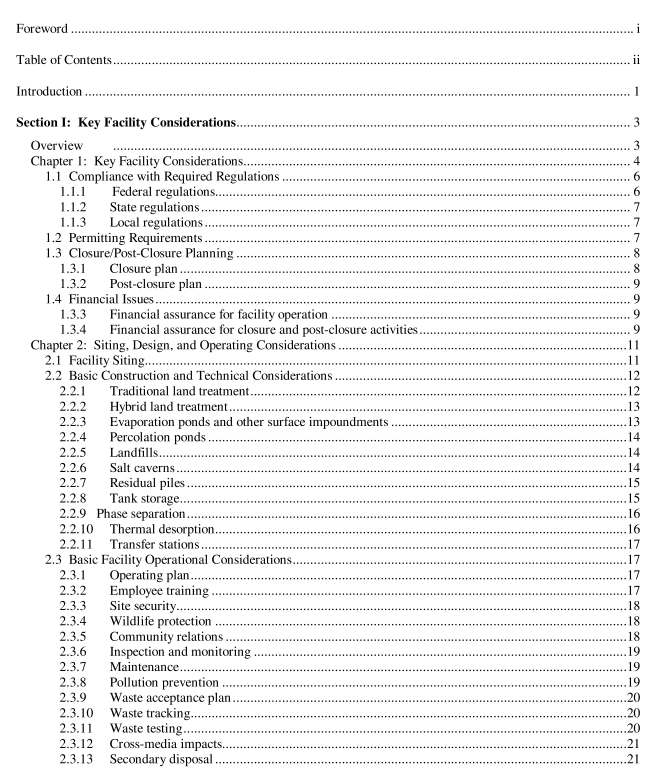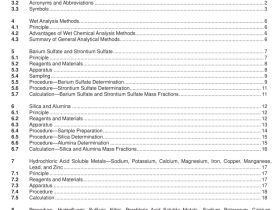API G00004 pdf download

API G00004 pdf download Guidelines for Commercial Exploration and Production Waste Management Facilities
♦ Hazardous Materials Transportation Act (HMTA).
Additional requirements may be imposed for those facilities located on lands administered by the Bureau of Land Management (BLM). The Federal Land Policy and Management Act of 1976 establishes comprehensive land use guidelines for BLM on properly managing the public lands under its jurisdiction. As such, facilities may be subject to additional BLM requirements where applicable.
1.1.2 State regulations Applicable state regulations can include air quality standards, permitting requirements, and siting criteria that may be significantly more stringent than existing federal regulations. For a complete listing of all state regulations applicable to the operation of an E&P waste management facility, it is recommended that facilities consult with the proper regulatory agency. In most cases, state agencies can be contacted on the World Wide Web at www.state.[state abbreviation].us (e.g., the State of Texas is www.state.tx.us). Summaries of selected state regulations specifically applicable to commercial E&P waste management facilities are provided in Appendix B of this document. Key state agency contacts can be found in Appendix C.
1.1.3 Local regulations Applicable local regulations may also include more stringent air and water quality standards, permitting requirements, operating conditions, and siting criteria. For a complete listing of all local regulations applicable to the operation of an E&P waste management facility, it is recommended that facilities consult with the proper regulatory agency. This information can usually be obtained by contacting the related state agency (see Appendix C).
1.2 Permitting Requirements Although many E&P wastes are exempt from RCRA Subtitle C hazardous waste regulations, facilities are likely to be responsible for complying with several state and local permitting requirements that may be more stringent than current federal regulations. To determine applicability, facilities should begin by completing a regulatory analysis of federal, state, and local laws to determine applicable permitting requirements (see section 1.1 of this document). The permits required will vary depending on a facility’s practices and operations. In many cases, even though a permit is required under federal law, the state may be the applicable permitting authority. State permitting requirements may also apply. Federal environmental permits applicable to commercial E&P waste management facilities could include, but may not be limited to the following:
♦ NPDES Permits under the Clean Water Act. National Pollutant Discharge Elimination System (NPDES) and/or state equivalents are required for point source discharges into U.S. waters.
♦ Storm Water Permits under the Clean Water Act. Part of the NPDES program, these regulations require that facilities discharging storm water associated with construction or industrial activity obtain an Individual, Group, or General Storm Water Permit.
♦ UIC Permits under the Safe Drinking Water Act. The Underground Injection Control (UIC) Program and individual state programs are designed to protect underground sources of drinking water; injection and disposal wells must be permitted through the UIC program. In some cases, production wells may also be covered by the UIC program.
♦ Clean Air Act Permits. If a facility’s emissions are above certain thresholds, or if the facility is located in an area that does not meet one or more national ambient air quality standards, an operating permit may be required. Additional permits may be required for construction activities.
♦ Solid Waste Disposal Facility Permits. Many states require a permit or other authorization (for example, a permit by-rule) for facilities that dispose of E&P wastes. If the facility handles other types of wastes, or generates wastes of its own, additional federal or state waste disposal permitting requirements may also apply.
Financial assurance (see section 1.4) and closure/post- closure (see section 1.3) provisions may also be included in a facility permit. After identifying applicable federal, state and local permit requirements, a facility should apply for all required permits, and upon issuance, comply with the requirements outlined in the permit. It is recommended that facilities implement a system for assuring compliance with permit terms and conditions, including the use of compliance audits. All permitting information should be kept up-to-date and on file in a location available to both regulators, customers, and facility auditors.









